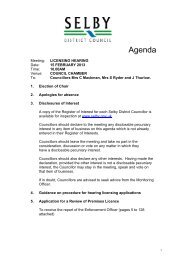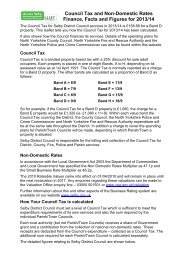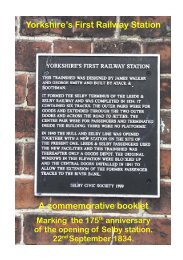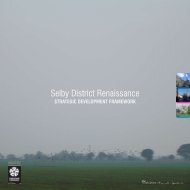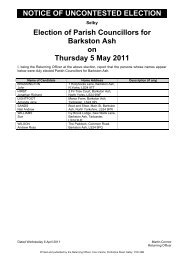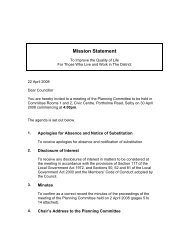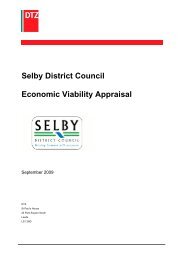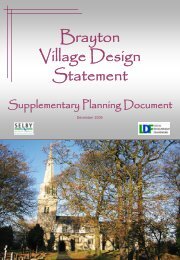You also want an ePaper? Increase the reach of your titles
YUMPU automatically turns print PDFs into web optimized ePapers that Google loves.
marked by a hedge or lane. Evidence of this pre-enclosure layout still remains<br />
today. Most plots on the south side of Main Street are 45 feet wide with a lane<br />
(once called Back Lane, now Field Lane) running across the bottom. The plots to<br />
the north (La Anchor) side are 90 feet wide.<br />
During the wide-ranging changes to council territories in 1974, Hensall’s western<br />
boundary was extended to include the Wand Lane and Dene Close properties<br />
around Gallows Hill. Prior to this date, the boundary was the Ancient Drain/ Beck<br />
Drain which runs behind Finkle Street and Dove Cote Gardens to the River Aire.<br />
Consequently, the area stretching from Hensall Farm and the Steam Mill west to<br />
the Gallows Hill area was in Eggborough. This drain is marked on the map<br />
above by the dark line and everything to the east, (where the name Hensall<br />
appears) was in Eggborough at this time.<br />
The view towards the Finkle Street/ Main Street T-Junction from the Eggborough<br />
side of Becks Drain showing the steam mill, cottages and semi-detached houses<br />
which open onto the street.<br />
To most people passing by on the A645 today, Hensall is a single street that<br />
dissects the A645 at the traffic lights outside St Paul’s Church. An attractive view<br />
of the church is offered on the south side, while the northern side features a<br />
variety of houses, many post war era.<br />
St Paul’s Church is the largest and arguably the most architecturally interesting<br />
building in the village. Lord Downe, who commissioned the build to impress his<br />
future wife, Lady Dawnay, lived in nearby Cowick Hall in the 19th Century. The<br />
Architect chosen was William Butterfield who was to design All Saints, Margaret<br />
Street and the Chapel of Keble College, Oxford. St Paul’s Church was one of<br />
three local churches (the others being Cowick and Pollington) simultaneously<br />
commissioned by Viscount Downe and built by Butterfield. The project also<br />
included a vicarage and a school built alongside each church. Newspaper<br />
accounts at the time state the foundation stones of each church were was laid on<br />
the 4th of July 1843. The churches at Cowick and Hensall were both<br />
60



